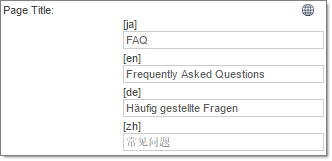This the multi-page printable view of this section. Click here to print.
User Guide
- 1: Welcome to the Connector
- 1.1: The Translation Lifecycle
- 1.2: How the Connector Helps You Manage Your Translation Lifecycle
- 1.3: Using this Guide
- 1.4: How to Contact Lionbridge Connector Support
- 2: Getting Started with the Connector
- 3: Sending Content for Translation
- 3.1: Sending Products for Translation from SAP Commerce or SAP Commerce Cloud
- 3.2: Sending Products for Translation from the Hybris Backoffice Product Cockpit (Hybris 6.4 and higher)
- 3.3: Sending Products for Translation from the Hybris Backoffice Products Page
- 3.4: Sending Products for Translation from the Hybris Product Cockpit (Hybris 6.1 to 6.6)
- 3.5: Sending Website Pages for Translation from SAP Commerce or SAP Commerce Cloud
- 3.6: Sending Website Pages for Translation from the Hybris Backoffice
- 3.7: Sending Website Pages for Translation from the Hybris WCMS Cockpit (Hybris 6.1 to 6.6)
- 3.8: Sending Items for Translation from the Translation Queue
- 4: Monitoring Translation Status
- 4.1: Translation Statuses
- 4.2: Viewing Job Details
- 4.3: Viewing Archived Jobs
- 5: Viewing Translated Content
- 5.1: Viewing Translated Products in SAP Commerce or SAP Commerce Cloud
- 5.2: Viewing Translated Products in the Hybris Backoffice Product Cockpit
- 5.3: Viewing Translated Products in the Hybris Backoffice Products Page
- 5.4: Viewing Translated Products in the Hybris Product Cockpit (Hybris 6.1 to 6.6)
- 5.5: Viewing Translated Website Pages in SAP Commerce or SAP Commerce Cloud
- 5.6: Viewing Translated Website Pages in the Hybris Backoffice
- 5.7: Viewing Translated Website Pages in the Hybris WCMS Cockpit (Hybris 6.1 to 6.6)
1 - Welcome to the Connector
Welcome to the Lionbridge Connector for SAP Commerce (“Connector”) version 3.0. This is Lionbridge’s connector for SAP Commerce and Hybris. The Connector enables you to automate sending and retrieving localized attributes in business objects, which dramatically reduces the effort required to create, maintain, and publish these items in multiple languages.
1.1 - The Translation Lifecycle
The translation lifecycle is the broad process of selecting content, sending it out for translation, and then receiving the translated content back from translation.
This set of steps usually fits inside a larger, more general process called the content lifecycle, which is the process of creating, reviewing, editing, approving, and publishing content.
When you consider the translation lifecycle and the content lifecycle together, you have the global content value chain, which is the strategy for managing multilingual content.
Remember that localizing content is a subset of steps in the broader content lifecycle. This will improve your focus on key localization considerations, improve processes, and keep all content stakeholders included. Together, this results in better content management.
1.2 - How the Connector Helps You Manage Your Translation Lifecycle
The Lionbridge Connector for SAP Commerce (“Connector”) is a plug-in module for Hybris, SAP Commerce, and SAP Commerce Cloud. It provides a range of features and user interface enhancements that enable you to select, send, monitor, and retrieve content for translation into any supported language.
These features automate the process, which dramatically reduces the effort and time required to export and re-import content that needs to be localized. This is very helpful when translating large volumes of content or ensuring that translated content is quickly re-imported to meet deadlines.
When you use the Connector, you manage your translation lifecycle entirely from within Hybris, SAP Commerce, or SAP Commerce Cloud (“e-commerce platform”):
- The Connector exports your content from the e-commerce platform in XML format and delivers these content files to the central, hosted Lionbridge Content API Platform.
- The Lionbridge Content API Platform delivers your content to your translation providers, based on routing rules that your company chooses and the Lionbridge Connector Team implements.
- When the translated content is ready, the Lionbridge Content API Platform retrieves it from your translators and delivers it to the Connector.
- The Connector automatically re-imports the content into the correct location in the e-commerce platform.
You can then review, revise, reject, or publish the translated content as needed.
Note: Neither the Connector nor the Lionbridge Content API Platform performs any translation. Similarly, the Lionbridge Connector Team does not provide any translation services. Your company chooses the translation provider that performs the translation.
1.3 - Using this Guide
Purpose of this guide
This guide describes how to use the Lionbridge Connector (“Connector”) for SAP Commerce to manage your translation lifecycle. It describes how to send out localized strings in certain business objects for translation and receive them back from translation.
Who should use this guide
This guide is intended for content editors, project, marketing, localization or translation managers, or others who are responsible for creating, editing, or approving business objects for translation. This guide is also useful for translation providers who receive business objects from your Hybris, SAP Commerce, or SAP Commerce Cloud installation, because it describes your company’s translation management process.
What your company setup should be
This document assumes that:
- Your company already has a functioning instance of Hybris, SAP Commerce, or SAP Commerce Cloud.
- The Connector has been installed, configured, and tested on your Hybris, SAP Commerce, or SAP Commerce Cloud instance.
- The Lionbridge Connector Team has set up the Lionbridge Content API Platform to send localized strings in certain business objects to your translation providers.
What you should already know
This document assumes that:
- You are familiar with the Connector’s configuration for Hybris, SAP Commerce, or SAP Commerce Cloud, and the reasons for choosing certain configuration options. This is important because your company’s configuration determines which features are available.
- You have a strong working knowledge of Hybris, SAP Commerce, or SAP Commerce Cloud, particularly the following modules:
- Hybris Backoffice
- Hybris Product Cockpit and/or Hybris WCMS Cockpit (Hybris versions 6.1 to 6.6 only)
- SAP Commerce or SAP Commerce Cloud Administration Cockpit
- You have valid user credentials to log into the Hybris, SAP Commerce, or SAP Commerce Cloud modules listed above.
- You are familiar with your company’s translation process and requirements.
- You have the required permissions to access the Connector functionality described in this guide.
Note: Not all the features described in this guide may be available. Feature availability depends on both your company’s Connector setup and the roles to which you are assigned. If you cannot access functionality that you need, contact your company’s Hybris, SAP Commerce, or SAP Commerce Cloud administrator.
How this guide is organized
This guide contains the following chapters
| Chapter | Description |
|---|---|
| Welcome to the Lionbridge Connector for SAP Commerce | A brief description of the Lionbridge Connector solution for Hybris, SAP Commerce, or SAP Commerce Cloud and how it fits into the translation lifecycle. It also includes information about this guide and Lionbridge Connector Support contact information. |
| Getting Started with the Lionbridge Connector for SAP Commerce | How to get started and an overview of the Connector interface and key features. |
| Sending Content for Translation | How to send out content for translation. |
| Monitoring Translation Status | How to monitor the translation status of content items and translation jobs. |
| Viewing Translated Content | How to view translated content. |
How to find out more about the Lionbridge Connector for SAP Commerce
For information on installing and configuring the Lionbridge Connector for SAP Commerce, read the Lionbridge Connector for SAP Commerce Installation and Configuration Guide.
Documentation conventions
This guide uses the following conventions:
| Convention | Description |
|---|---|
| Bold | Highlights screen elements such as buttons, menu items, and fields. |
| Courier | Highlights input, file names, and paths. |
| Italics | Highlights terms for emphasis, variables, or document titles. |
| > | Indicates a menu choice. For example, “Select Catalog > Products.” |
1.4 - How to Contact Lionbridge Connector Support
How to Contact Lionbridge Connector Support
You can submit a support ticket either:
- by emailing connectors@lionbridge.com
- from the Lionbridge Connector Zendesk page https://lionbridge-connectors.zendesk.com/
See also:
2 - Getting Started with the Connector
The Connector supports all Web browsers that SAP Commerce supports.
Important: You must configure your browser to allow pop-up windows on the SAP Commerce server.
The Connector functionality is available in the following modules:
- Administration Cockpit SAP Commerce and SAP Commerce Cloud
This module contains Connector setup and configuration options, the Translation Queue, and functionality for sending out products and website pages for translation, monitoring job status, and archiving jobs.
-
To access the Administration Cockpit, in your Web browser, open http://your_SAP_Commerce_instance/backoffice/login.zul and log in.
-
Hybris Backoffice Administration Cockpit (“Backoffice”)
This module contains Connector setup and configuration options, the Translation Queue, and functionality for sending out products and website pages for translation, monitoring job status, and archiving jobs.
-
To access Backoffice, in your Web browser, open http://your_hybris_instance/backoffice/login.zul and log in.
-
Hybris Product Cockpit (Hybris versions 6.1 to 6.6 only)
This module contains the functionality for sending out products to the Translation Queue or directly for translation.
-
To access the Product Cockpit, in your Web browser, open http://your_hybris_instance/ctcockpit/login.zul and log in.
-
Hybris WCMS Cockpit (Hybris versions 6.1 to 6.6 only)
This module contains the functionality for sending out website pages to the Translation Queue or directly for translation.
- To access the WCMS Cockpit, in your Web browser, open http://your_hybris_instance/ctwcms/login.zul and log in.
2.1 - The Connector at a Glance
The Connector has interfaces in the following modules:
- SAP Commerce and SAP Commerce Cloud Administration Cockpit](#)

This module includes the following Connector interfaces:
-
Product Cockpit
-
Pages page (opened from WCMS > Pages in the navigation tree on the left)
-
Products page (opened from Catalog > Products in the navigation tree on the left)
-
Translation Queue
-
Translation Jobs page, and the related Job Details page and Archived Jobs page
-
System Configuration page, where you configure the Connector
-
Content Mapping page, where you configure:
- which business objects, sub-types, and localized attributes the Connector sends for translation
- the product classification attributes of business objects that are Products for the Connector to send for translation
-
System Information page, where you can view the Connector version and build information
-
Hybris Backoffice Administration Cockpit (“Backoffice”)](#)
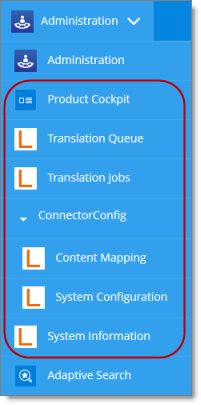
This module includes the following Connector interfaces:
-
Product Cockpit (Hybris versions 6.4 and higher only)
-
Pages page (opened from WCMS > Pages in the navigation tree on the left)
-
Products page (opened from Catalog > Products in the navigation tree on the left)
-
Translation Queue
-
Translation Jobs page, and the related Job Details page and Archived Jobs page
-
System Configuration page, where you configure the Connector
-
Content Mapping page, where you configure:
- which business objects, sub-types, and localized attributes the Connector sends for translation
- the product classification attributes of business objects that are Products for the Connector to send for translation
-
System Information page, where you can view the Connector version and build information
-
Hybris Product Cockpit (Hybris versions 6.1 to 6.6 only)](#)

This module includes the Connector interface for sending products to the Translation Queue and directly out for translation.
- Hybris WCMS Cockpit (Hybris versions 6.1 to 6.6 only)](#)
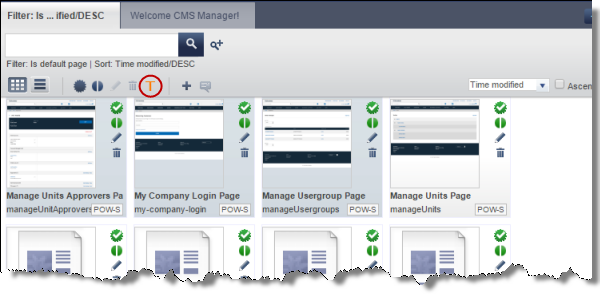
This module includes the Connector interface for sending website pages to the Translation Queue and directly out for translation.
3 - Sending Content for Translation
You use the Connector to send out localized attributes, including keywords, of business objects in the Administration Cockpit, the Product Cockpit and the WCMS Cockpit (Hybris versions 6.1 to 6.6 only), and the Backoffice Cockpit, specifically products and website pages, for translation.
When the Connector sends out a business object for translation, it actually sends out the configured localized attributes in that business object for translation. You can send out for translation any configured localized attributes of any configured business object.
Each localized attribute of a business object that is sent out for translation is a content item.
Note: Although you can view non-localized attributes and select them to send them out for translation, the Connector does not actually send out non-localized attributes for translation.
Note: You configure which business objects, sub-types, and corresponding localized attributes you can send out for translation in the Content Mapping page. For detailed instructions, refer to the Lionbridge Connector for SAP Commerce Installation and Configuration Guide.
- In SAP Commerce or SAP Commerce Cloud, you can send out products for translation from the Product Cockpit. For detailed instructions, see: Sending Products for Translation from SAP Commerce or SAP Commerce Cloud.
- In Hybris version 6.4 or higher, you can send out products for translation from the Hybris Backoffice Product Cockpit. For detailed instructions, see: Sending Products for Translation from the Hybris Backoffice Product Cockpit (Hybris 6.4 and higher).
- In all supported versions of Hybris, you can send out products for translation from the Hybris Backoffice Products page. For detailed instructions, see: Sending Products for Translation from the Hybris Backoffice Products Page.
- In Hybris versions 6.1 to 6.6, you can send out products for translation from the Hybris Product cockpit. For detailed instructions, see: Sending Products for Translation from the Hybris Product Cockpit (Hybris 6.1 to 6.6).
- In SAP Commerce or SAP Commerce Cloud, you can send out website pages for translation from the Administration Cockpit. For detailed instructions, see: Sending Website Pages for Translation from SAP Commerce or SAP Commerce Cloud.
- In all supported versions of Hybris, you can send out website pages for translation from within Hybris Backoffice. For detailed instructions, see: Sending Website Pages for Translation from the Hybris Backoffice.
- In Hybris versions 6.1 to 6.6, you can send out website pages for translation from the Hybris WCMS cockpits. For detailed instructions, see: Sending Website Pages for Translation from the Hybris WCMS Cockpit (Hybris 6.1 to 6.6).
3.1 - Sending Products for Translation from SAP Commerce or SAP Commerce Cloud
You use the Connector to send out configured localized attributes of products for translation from SAP Commerce or SAP Commerce Cloud.
Note: You configure which localized attributes of products you can send out for translation in the Content Mapping page. For detailed instructions, refer to the Lionbridge Connector for SAP Commerce Installation and Configuration Guide.
To send out the localized attributes of business objects that are products for translation from SAP Commerce or SAP Commerce Cloud:
- In your Web browser, navigate to /backoffice/ on your SAP Commerce instance or on SAP Commerce Cloud.
- Log in to SAP Commerce or SAP Commerce Cloud.
- In the Administration Cockpit menu, select Product Cockpit.
- In the bottom-right corner, click the arrow to display the left menu
 .
. - In the left menu, select Products.
The Products page opens.

-
Optional. In the Filter Tree in the left pane, you can select a specific catalog or classification, and price range and/or category to display only products that meet the filter criteria.
-
Locate the products to send out for translation. You can view the items in either the Grid view
 or the List view
or the List view  .
.
Tip: You can use the search and filter functionality at the top of the page to display only the products to send out for translation.
- Select the products to translate.
Note: All selected items must have the same source language.
- In the Grid view, click a checkmark
 in the top-left corner to select it and the corresponding product.
in the top-left corner to select it and the corresponding product. - In the List view, click a checkmark
 in the left column to select it and the corresponding product.
in the left column to select it and the corresponding product.
Tip about selecting all displayed products: To send all the displayed products for translation, view them in the List view
and then select the check box in the column header. For example, to send all products in a catalog for translation, click the catalog in the Filter Tree in the left pane, and then select the check box in the column header.
- In the toolbar, click the Translate action button
 .
.
The Job Type page of the Send to translation wizard opens.
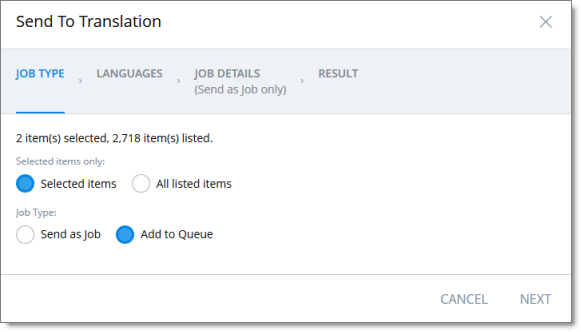
This page displays the number of items selected and the number of items available for selection.
- In the Job Type page, you specify the following settings:
- which items the Connector will send for translation. Select one of the following radio buttons:
- Selected items: These are the items you selected in step 6, above.
- All listed items: All the items that were availabe for selection, after the filtering in step 4, above.
- how the Connector will process the items to send for translation. Select one of the following radio buttons:
- Send as Job: The Connector will send out the items for translation as a single job. The Connector will send the job to the Lionbridge Content API Platform, which will send it to the translation provider that you will specify later in this wizard.
- Add to Queue (the default selection): The Connector will send the items to the Translation Queue, where a user must send them out for translation.
When you are done, click Next.
The Languages page of the wizard opens.

- In the Languages page, you specify the following settings:
- Source Language: Select the source language of the items from the dropdown list. The Connector will send items in this source language for translation.
Note: All selected items must have the same source language.
- Target Languages: Select one or more target languages, into which to translate the items. The list displays all the languages that are set up for the Connector.
When you are done, do one of the following:
- If you selected Add to Queue in the Job Type page of the wizard, click Add to Queue.
Note: The Add to Queue button is available only if you selected Add to Queue in the Job Type page of the wizard.
The Result page of the wizard opens, displaying the number of items that the Connector sent to the Translation Queue.
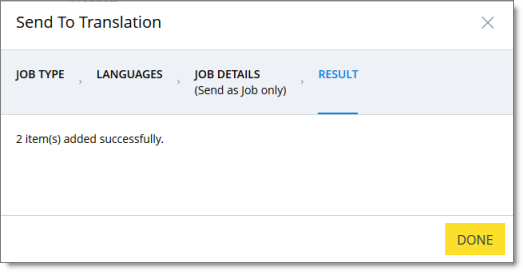
Click Done to close the wizard.
Important: You must open the Translation Queue to send out these items for translation. For detailed instructions, see Sending Items for Translation from the Translation Queue.
- If you selected Send as job in the Job Type page of the wizard, click Next.
Note: The Next button is displayed only if you selected Send as job in the Job Type page of the wizard.
- If you clicked Next, the Job Details page of the wizard opens.
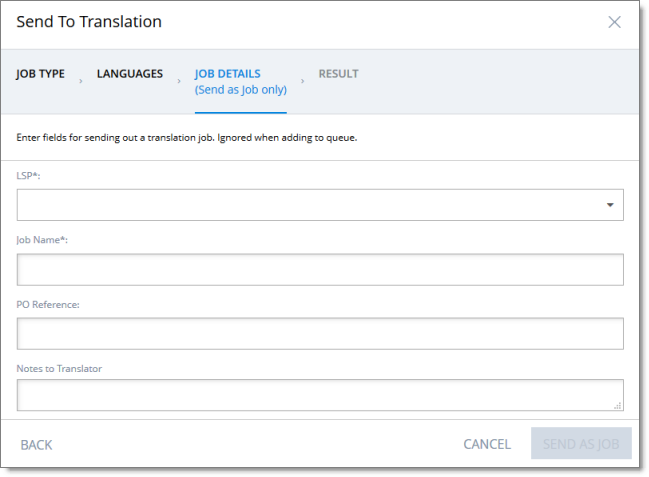
In the page you specify the following job settings:
Note: You specify job settings for the items you sent to the Translation Queue when you send them out for translation from the queue, as described in Sending Items for Translation from the Translation Queue.
| Field | Description |
|---|---|
| LSP | Select the translation provider for this translation job from the list. |
| Job Name | Your name for this translation job. A translation job contains all the items that the Connector sends out together for translation. |
| PO Reference | The purchase order reference number. |
| Notes to Translator | Any special instructions or requests. Note: Displayed only when any translation provider other than Lionbridge Freeway is selected in the LSP field, above. |
| Special Instructions | Any special instructions or requests. Note: Displayed only when the Lionbridge Freeway translation provider is selected in the LSP field, above. |
| Analysis Codes | You can specify the configured Lionbridge Freeway analysis codes for the translation job. Note: Displayed only when the Lionbridge Freeway translation provider is selected in the LSP field, above. |
When you are done, click Send as Job.
The Results page of the wizard opens, displaying the number of products the Connector sent for translation.
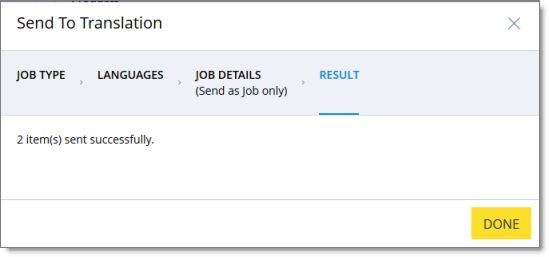
- Click Done to close the wizard.
Tip: You can monitor the progress of your job on the Translation Jobs page. For details, see Monitoring Translation Status.
3.2 - Sending Products for Translation from the Hybris Backoffice Product Cockpit (Hybris 6.4 and higher)
Note: This functionality is supported only for Hybris versions 6.4 and higher.
You use the Connector to send out configured localized attributes of products for translation from the Hybris Backoffice Product Cockpit.
Note: You configure which localized attributes of products you can send out for translation in the Content Mapping page. For detailed instructions, refer to the Lionbridge Connector for SAP Commerce Installation and Configuration Guide.
To send out the localized attributes of business objects that are products for translation from the Backoffice Product Cockpit:
- In your Web browser, navigate to /backoffice/ on your Hybris instance.
- Log in to the Hybris Backoffice.
- In the Administration menu, select Product Cockpit.
The Products page opens.

- Optional. In the Filter Tree in the left pane, you can select a specific catalog or classification, and price range and/or category to display only products that meet the filter criteria.

- Locate the products to send out for translation. You can view the items in either the Grid view
 or the List view
or the List view  .
.
Tip: You can use the search and filter functionality at the top of the page to display only the products to send out for translation.
- Select the products to translate.
Note: All selected items must have the same source language.
- In the Grid view, click a checkmark
 in the top-left corner to select it and the corresponding product.
in the top-left corner to select it and the corresponding product. - In the List view, click a checkmark
 in the left column to select it and the corresponding product.
in the left column to select it and the corresponding product.
Tip about selecting all displayed products: To send all the displayed products for translation, view them in the List view
and then select the check box in the column header. For example, to send all products in a catalog for translation, click the catalog in the Filter Tree in the left pane, and then select the check box in the column header.
- In the toolbar, click the Translate action button
 .
.
The Job Type page of the Send to translation wizard opens.

This page displays the number of items selected and the number of items available for selection.
- In the Job Type page, you specify the following settings:
- which items the Connector will send for translation. Select one of the following radio buttons:
- Selected items: These are the items you selected in step 6, above.
- All listed items: All the items that were availabe for selection, after the filtering in step 4, above.
- how the Connector will process the items to send for translation. Select one of the following radio buttons:
- Send as Job: The Connector will send out the items for translation as a single job. The Connector will send the job to the Lionbridge Connector API Platform, which will send it to the translation provider that you will specify later in this wizard.
- Add to Queue (the default selection): The Connector will send the items to the Translation Queue, where a user must send them out for translation.
When you are done, click Next.
The Languages page of the wizard opens.

- In the Languages page, you specify the following settings:
- Source Language: Select the source language of the items from the dropdown list. The Connector will send items in this source language for translation.
Note: All selected items must have the same source language.
- Target Languages: Select one or more target languages, into which to translate the items. The list displays all the languages that are set up for the Connector.
When you are done, do one of the following:
- If you selected Add to Queue in the Job Type page of the wizard, click Add to Queue.
Note: The Add to Queue button is available only if you selected Add to Queue in the Job Type page of the wizard.
The Result page of the wizard opens, displaying the number of items that the Connector sent to the Translation Queue.

Click Done to close the wizard.
Important: You must open the Translation Queue to send out these items for translation. For detailed instructions, see Sending Items for Translation from the Translation Queue.
- If you selected Send as job in the Job Type page of the wizard, click Next.
Note: The Next button is displayed only if you selected Send as job in the Job Type page of the wizard.
- If you clicked Next, the Job Details page of the wizard opens.

In the page you specify the following job settings:
Note: You specify job settings for the items you sent to the Translation Queue when you send them out for translation from the queue, as described in Sending Items for Translation from the Translation Queue.
| Field | Description |
|---|---|
| LSP | Select the translation provider for this translation job from the list. |
| Job Name | Your name for this translation job. A translation job contains all the items that the Connector sends out together for translation. |
| PO Reference | The purchase order reference number. |
| Notes to Translator | Any special instructions or requests. Note: Displayed only when any translation provider other than Lionbridge Freeway is selected in the LSP field, above. |
| Special Instructions | Any special instructions or requests. Note: Displayed only when the Lionbridge Freeway translation provider is selected in the LSP field, above. |
| Analysis Codes | You can specify the configured Lionbridge Freeway analysis codes for the translation job. Note: Displayed only when the Lionbridge Freeway translation provider is selected in the LSP field, above. |
When you are done, click Send as Job.
The Results page of the wizard opens, displaying the number of products the Connector sent for translation.

- Click Done to close the wizard.
Tip: You can monitor the progress of your job on the Translation Jobs page. For details, see Monitoring Translation Status.
3.3 - Sending Products for Translation from the Hybris Backoffice Products Page
You use the Connector to send out configured localized attributes of products for translation from the Backoffice Products page.
Note: You configure which localized attributes of products you can send out for translation in the Content Mapping page. For detailed instructions, refer to the Lionbridge Connector for SAP Commerce Installation and Configuration Guide.
To send out the localized attributes of business objects for translation from the Backoffice Products page:
- In your Web browser, navigate to /backoffice/ on your Hybris instance.
- Log in to the Hybris Backoffice.
- Ensure that the Administration menu is selected.
- In the navigation tree on the left, navigate to Catalog > Products.
The Products page opens.

- Locate the products to send out for translation. You can view the products in the List View
 , Tree View
, Tree View  , or the Grid View
, or the Grid View  mode.
mode.
Tip: You can use the search and advanced search functionality to display only the products to send out for translation.
- Select the products to translate:
-
In the List view
 , click a checkmark
, click a checkmark  in the left column to select it and the corresponding page.
in the left column to select it and the corresponding page. -
In the Tree view
 , select a check box to select the corresponding page.
, select a check box to select the corresponding page. -
In the Grid view
 , select a a checkmark
, select a a checkmark  in the left column to select it and the corresponding page.
in the left column to select it and the corresponding page.
Tips: To select a range of adjacent products, press the Shift key. To select multiple non-adjacent products, press the Ctrl key. Before selecting products, ensure that the lock icon ![]() is displayed in the top-right corner. If the unlock icon
is displayed in the top-right corner. If the unlock icon ![]() is displayed, click it to toggle it to the lock icon.
is displayed, click it to toggle it to the lock icon.
- In the toolbar, click the Send selection to translation button
 .
.
The Job Type page of the Send to translation wizard opens.

This page displays the number of items selected and the number of items available for selection.
- In the Job Type page, you specify the following settings:
- which items the Connector will send for translation. Select one of the following radio buttons:
- Selected items: These are the items you selected in step 6, above.
- All listed items: All the items that were availabe for selection, after the filtering in step 4, above.
- how the Connector will process the items to send for translation. Select one of the following radio buttons:
- Send as Job: The Connector will send out the items for translation as a single job. The Connector will send the job to the Lionbridge Connector API Platform, which will send it to the translation provider that you will specify later in this wizard.
- Add to Queue (the default selection): The Connector will send the items to the Translation Queue, where a user must send them out for translation.
When you are done, click Next.
The Languages page of the wizard opens.

- In the Languages page, you specify the following settings:
- Source Language: Select the source language of the items from the dropdown list. The Connector will send items in this source language for translation.
Note: All selected items must have the same source language.
- Target Languages: Select one or more target languages, into which to translate the items. The list displays all the languages that are set up for the Connector.
When you are done, do one of the following:
- If you selected Add to Queue in the Job Type page of the wizard, click Add to Queue.
Note: The Add to Queue button is available only if you selected Add to Queue in the Job Type page of the wizard.
The Result page of the wizard opens, displaying the number of items that the Connector sent to the Translation Queue.

Click Done to close the wizard.
Important: You must open the Translation Queue to send out these items for translation. For detailed instructions, see Sending Items for Translation from the Translation Queue.
- If you selected Send as job in the Job Type page of the wizard, click Next.
Note: The Next button is displayed only if you selected Send as job in the Job Type page of the wizard.
- If you clicked Next, the Job Details page of the wizard opens.

In the page you specify the following job settings:
Note: You specify job settings for the items you sent to the Translation Queue when you send them out for translation from the queue, as described in Sending Items for Translation from the Translation Queue.
| Field | Description |
|---|---|
| LSP | Select the translation provider for this translation job from the list. |
| Job Name | Your name for this translation job. A translation job contains all the items that the Connector sends out together for translation. |
| PO Reference | The purchase order reference number. |
| Notes to Translator | Any special instructions or requests. Note: Displayed only when any translation provider other than Lionbridge Freeway is selected in the LSP field, above. |
| Special Instructions | Any special instructions or requests. Note: Displayed only when the Lionbridge Freeway translation provider is selected in the LSP field, above. |
| Analysis Codes | You can specify the configured Lionbridge Freeway analysis codes for the translation job. Note: Displayed only when the Lionbridge Freeway translation provider is selected in the LSP field, above. |
When you are done, click Send as Job.
The Results page of the wizard opens, displaying the number of products the Connector sent for translation.

- Click Done to close the wizard.
Tip: You can monitor the progress of your job on the Translation Jobs page. For details, see Monitoring Translation Status.
3.4 - Sending Products for Translation from the Hybris Product Cockpit (Hybris 6.1 to 6.6)
Note: This functionality is supported only for Hybris versions 6.1 to 6.6.
Notes: In Hybris 6.4 or higher, you can also send products for translation from the Hybris Backoffice Product Cockpit. For detailed instructions, see Sending Products for Translation from the Hybris Backoffice Product Cockpit (Hybris 6.4 and higher). In all supported versions of Hybris, you can also send products for translation from the Hybris Backoffice Products page. For detailed instructions, see Sending Products for Translation from the Hybris Backoffice Products Page.
You use the Connector to send out configured localized attributes of products for translation from the Hybris Product Cockpit.
Note: You configure which localized attributes of products you can send out for translation in the Content Mapping page. For detailed instructions, refer to the Lionbridge Connector for SAP Commerce Installation and Configuration Guide.
To send out the localized attributes of business objects for translation from the Product Cockpit:
-
In your Web browser, navigate to /ctcockpit/ on your Hybris instance.
-
Log in to the Hybris Product Cockpit.
-
In the All Products tab, locate the products to send out for translation. You can view the items in either the Grid view or the List view.
Tip: You can use the search, advanced search, and saved search query functionality to display only the products to send out for translation.
- Select the products to translate.
Tips: To select a range of adjacent business objects, press the Shift key. To select multiple non-adjacent products, press the Ctrl key.
Tip about catalogs: To send all the products in a catalog for translation, click the catalog in the left pane and then select all the objects within it.
- In the toolbar, click the Send selection to translation button
 .
.
The first page of the Send selection to translation wizard opens.

The following information is displayed about each product you selected previously:
- Article Number: The product code.
- Identifier: The product identifier.
These are both displayed in the List view in the Product Cockpit.
Tip: You can clear the check box for any product you do not want to send out for translation.
- Select one of the following radio buttons:
- Add to Translation Queue (the default selection): The Connector sends the content items to the Translation Queue, where a user must send them out for translation.
- Send to Translation Now: The Connector sends the content items to the Lionbridge Content API Platform, which sends them to the translation provider specified in the company’s routing rules. The Connector displays additional fields below, where you can specify additional information about this translation job.
Note: This setting determines which fields are displayed on the following page of the wizard.
-
Click Next.
-
One of the following happens.
- If you previously selected the Add to Translation Queue radio button, the second page of the wizard is displayed as follows:
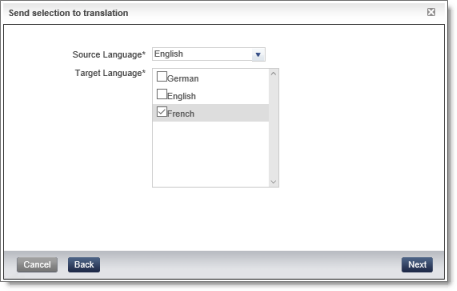
- If you previously selected the Send to Translation Now radio button, the second page of the wizard is displayed as follows:
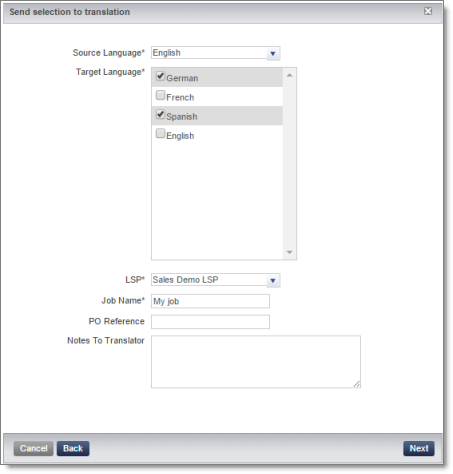
- Enter the following information about the content items to translate:
| Field | Description |
|---|---|
| Source Language | Required. Select the source language of the selected items to send for translation. Note: All selected items must have the same source language. |
| Target Language | Required. Select the check boxes of one or more target languages into which to translate the content. |
| LSP | Select the translation provider for this translation job from the list. Required and displayed only if you selected the Send to Translation Now radio button in the previous page of the wizard. |
| Job Name | Your name for this translation job. A translation job contains all the content items that the Connector sends out together for translation. Required and displayed only if you selected the Send to Translation Now radio button in the previous page of the wizard. |
| PO Reference | The purchase order reference number. Displayed only if you selected the Send to Translation Now radio button in the previous page of the wizard. |
| Notes to Translator | Any special instructions or requests. Displayed only if you selected the Send to Translation Now radio button in the previous page of the wizard and when any translation provider other than Lionbridge Freeway is selected in the LSP field, above. |
| Special Instructions | Any special instructions or requests. Displayed only when both: * Send to Translation is selected in the previous page of the wizard. * The Lionbridge Freeway translation provider is selected in **Choose LSP**, above. |
| Analysis Codes | You can specify the configured Lionbridge Freeway analysis codes for the translation job. Displayed only when both: * Send to Translation is selected in the previous page of the wizard. * The Lionbridge Freeway translation provider is selected in **Choose LSP**, above. |
- Click Next.
Note: The Next button is displayed only after at least one target language is selected.
-
If you selected the Send to Translation Now radio button in the previous page of the wizard, then the final page of the wizard states the number of items that were sent out to translation. Click Done to close the wizard.
-
If you selected the Add to Translation Queue radio button in the previous page of the wizard, then the final page of the wizard states the number of items that were sent to the queue. Click Done to close the wizard.
Important: You must open the Translation Queue to send out these items for translation. For detailed instructions, see Sending Items for Translation from the Translation Queue.
3.5 - Sending Website Pages for Translation from SAP Commerce or SAP Commerce Cloud
You use the Connector to send out website pages (“pages”) for translation from the Hybris Backoffice.
When the Connector sends out pages for translation, it actually sends out the configured localized attributes of the content in that page for translation.
Each localized attribute of a business object that is sent out for translation is a content item.
Note: Although you can view non-localized attributes and select them to send them out for translation, the Connector does not actually send out non-localized attributes for translation.
Note: You configure which pages (Content Page objects) and corresponding localized attributes you can send out for translation in the Content Mapping page. For detailed instructions, refer to the Lionbridge Connector for SAP Commerce Installation and Configuration Guide.
To send out website pages for translation from WCMS:
- In your Web browser, navigate to /backoffice/ on your SAP Commerce instance or on SAP Commerce Cloud.
- Log in to SAP Commerce or SAP Commerce Cloud.
- Ensure that the Administration Cockpit menu is selected. This is the default menu selection.
- In the navigation tree on the left, navigate to WCMS > Page.
The page that opens displays a list of website pages.

- Locate the website pages to send out for translation. You can view the pages in the List View
 , Tree View
, Tree View  , or the Grid View
, or the Grid View  mode.
mode.
Tip: You can use the search and advanced search functionality to display only the website pages to send out for translation.
- Select the website pages to translate:
-
In the List view
 , click a checkmark
, click a checkmark  in the left column to select it and the corresponding page.
in the left column to select it and the corresponding page. -
In the Tree view
 , select a check box to select the corresponding page.
, select a check box to select the corresponding page. -
In the Grid view
 , select a a checkmark
, select a a checkmark  in the left column to select it and the corresponding page.
in the left column to select it and the corresponding page.
Tips: To select a range of adjacent pages, press the Shift key. To select multiple non-adjacent pages, press the Ctrl key. Before selecting pages, ensure that the lock icon
is displayed in the top-right corner. If the unlock icon
is displayed, click it to toggle it to the lock icon.
- In the toolbar, click the Send selection to translation button
 .
.
The Job Type page of the Send to translation wizard opens.

This page displays the number of items selected and the number of items available for selection.
- In the Job Type page, you specify the following settings:
- which items the Connector will send for translation. Select one of the following radio buttons:
- Selected items: These are the items you selected in step 6, above.
- All listed items: All the items that were availabe for selection, after the filtering in step 4, above.
- how the Connector will process the items to send for translation. Select one of the following radio buttons:
- Send as Job: The Connector will send out the items for translation as a single job. The Connector will send the job to the Lionbridge Connector API Platform, which will send it to the translation provider that you will specify later in this wizard.
- Add to Queue (the default selection): The Connector will send the items to the Translation Queue, where a user must send them out for translation.
When you are done, click Next.
The Languages page of the wizard opens.

- In the Languages page, you specify the following settings:
- Source Language: Select the source language of the items from the dropdown list. The Connector will send items in this source language for translation.
Note: All selected items must have the same source language.
- Target Languages: Select one or more target languages, into which to translate the items. The list displays all the languages that are set up for the Connector.
When you are done, do one of the following:
- If you selected Add to Queue in the Job Type page of the wizard, click Add to Queue.
Note: The Add to Queue button is available only if you selected Add to Queue in the Job Type page of the wizard.
The Result page of the wizard opens, displaying the number of items that the Connector sent to the Translation Queue.

Click Done to close the wizard.
Important: You must open the Translation Queue to send out these items for translation. For detailed instructions, see Sending Items for Translation from the Translation Queue.
- If you selected Send as job in the Job Type page of the wizard, click Next.
Note: The Next button is displayed only if you selected Send as job in the Job Type page of the wizard.
- If you clicked Next, the Job Details page of the wizard opens.

In the page you specify the following job settings:
Note: You specify job settings for the items you sent to the Translation Queue when you send them out for translation from the queue, as described in Sending Items for Translation from the Translation Queue.
| Field | Description |
|---|---|
| LSP | Select the translation provider for this translation job from the list. |
| Job Name | Your name for this translation job. A translation job contains all the items that the Connector sends out together for translation. |
| PO Reference | The purchase order reference number. |
| Notes to Translator | Any special instructions or requests. Note: Displayed only when any translation provider other than Lionbridge Freeway is selected in the LSP field, above. |
| Special Instructions | Any special instructions or requests. Note: Displayed only when the Lionbridge Freeway translation provider is selected in the LSP field, above. |
| Analysis Codes | You can specify the configured Lionbridge Freeway analysis codes for the translation job. Note: Displayed only when the Lionbridge Freeway translation provider is selected in the LSP field, above. |
When you are done, click Send as Job.
The Results page of the wizard opens, displaying the number of products the Connector sent for translation.

- Click Done to close the wizard.
Tip: You can monitor the progress of your job on the Translation Jobs page. For details, see Monitoring Translation Status.
3.6 - Sending Website Pages for Translation from the Hybris Backoffice
You use the Connector to send out website pages (“pages”) for translation from the Hybris Backoffice.
When the Connector sends out pages for translation, it actually sends out the configured localized attributes of the content in that page for translation.
Each localized attribute of a business object that is sent out for translation is a content item.
Note: Although you can view non-localized attributes and select them to send them out for translation, the Connector does not actually send out non-localized attributes for translation.
Note: You configure which pages (Content Page objects) and corresponding localized attributes you can send out for translation in the Content Mapping page. For detailed instructions, refer to the Lionbridge Connector for SAP Commerce Installation and Configuration Guide.
To send out website pages for translation from WCMS:
- In your Web browser, navigate to /backoffice/ on your Hybris instance.
- Log in to the Hybris Backoffice.
- Ensure that the Administration menu is selected.
- In the navigation tree on the left, navigate to WCMS > Page.
The page that opens displays a list of website pages.

- Locate the website pages to send out for translation. You can view the pages in the List View
 , Tree View
, Tree View  , or the Grid View
, or the Grid View  mode.
mode.
Tip: You can use the search and advanced search functionality to display only the website pages to send out for translation.
- Select the website pages to translate:
-
In the List view
 , click a checkmark
, click a checkmark  in the left column to select it and the corresponding page.
in the left column to select it and the corresponding page. -
In the Tree view
 , select a check box to select the corresponding page.
, select a check box to select the corresponding page. -
In the Grid view
 , select a a checkmark
, select a a checkmark  in the left column to select it and the corresponding page.
in the left column to select it and the corresponding page.
Tips: To select a range of adjacent pages, press the Shift key. To select multiple non-adjacent pages, press the Ctrl key. Before selecting pages, ensure that the lock icon
is displayed in the top-right corner. If the unlock icon
is displayed, click it to toggle it to the lock icon.
- In the toolbar, click the Send selection to translation button
 .
.
The Job Type page of the Send to translation wizard opens.

This page displays the number of items selected and the number of items available for selection.
- In the Job Type page, you specify the following settings:
- which items the Connector will send for translation. Select one of the following radio buttons:
- Selected items: These are the items you selected in step 6, above.
- All listed items: All the items that were availabe for selection, after the filtering in step 4, above.
- how the Connector will process the items to send for translation. Select one of the following radio buttons:
- Send as Job: The Connector will send out the items for translation as a single job. The Connector will send the job to the Lionbridge Connector API Platform, which will send it to the translation provider that you will specify later in this wizard.
- Add to Queue (the default selection): The Connector will send the items to the Translation Queue, where a user must send them out for translation.
When you are done, click Next.
The Languages page of the wizard opens.

- In the Languages page, you specify the following settings:
- Source Language: Select the source language of the items from the dropdown list. The Connector will send items in this source language for translation.
Note: All selected items must have the same source language.
- Target Languages: Select one or more target languages, into which to translate the items. The list displays all the languages that are set up for the Connector.
When you are done, do one of the following:
- If you selected Add to Queue in the Job Type page of the wizard, click Add to Queue.
Note: The Add to Queue button is available only if you selected Add to Queue in the Job Type page of the wizard.
The Result page of the wizard opens, displaying the number of items that the Connector sent to the Translation Queue.

Click Done to close the wizard.
Important: You must open the Translation Queue to send out these items for translation. For detailed instructions, see Sending Items for Translation from the Translation Queue.
- If you selected Send as job in the Job Type page of the wizard, click Next.
Note: The Next button is displayed only if you selected Send as job in the Job Type page of the wizard.
- If you clicked Next, the Job Details page of the wizard opens.

In the page you specify the following job settings:
Note: You specify job settings for the items you sent to the Translation Queue when you send them out for translation from the queue, as described in Sending Items for Translation from the Translation Queue.
| Field | Description |
|---|---|
| LSP | Select the translation provider for this translation job from the list. |
| Job Name | Your name for this translation job. A translation job contains all the items that the Connector sends out together for translation. |
| PO Reference | The purchase order reference number. |
| Notes to Translator | Any special instructions or requests. Note: Displayed only when any translation provider other than Lionbridge Freeway is selected in the LSP field, above. |
| Special Instructions | Any special instructions or requests. Note: Displayed only when the Lionbridge Freeway translation provider is selected in the LSP field, above. |
| Analysis Codes | You can specify the configured Lionbridge Freeway analysis codes for the translation job. Note: Displayed only when the Lionbridge Freeway translation provider is selected in the LSP field, above. |
When you are done, click Send as Job.
The Results page of the wizard opens, displaying the number of products the Connector sent for translation.

- Click Done to close the wizard.
Tip: You can monitor the progress of your job on the Translation Jobs page. For details, see Monitoring Translation Status.
3.7 - Sending Website Pages for Translation from the Hybris WCMS Cockpit (Hybris 6.1 to 6.6)
Note: This functionality is supported only for Hybris versions 6.1 to 6.6.
Note: In all supported versions of Hybris, you can also send website pages for translation from the Hybris Backoffice. For detailed instructions, see Sending Website Pages for Translation from the Hybris Backoffice.
You use the Connector to send out website pages (“pages”) for translation from the Hybris WCMS Cockpit.
When the Connector sends out pages for translation, it actually sends out the configured localized attributes of the content in that page for translation.
Each localized attribute of a business object that is sent out for translation is a content item.
Note: Although you can view non-localized attributes and select them to send them out for translation, the Connector does not actually send out non-localized attributes for translation.
Note: You configure which business objects and corresponding localized attributes you can send out for translation in the Content Mapping page. For detailed instructions, refer to the Lionbridge Connector for SAP Commerce Installation and Configuration Guide.
To send out website pages for translation from WCMS:
- In your Web browser, navigate to /ctwcms/ on your Hybris instance.
- Log in to the Hybris WCMS Cockpit.
- In the navigation area, in the Websites box, click the catalog version of the website whose pages you want to translate. You can view website pages in either the Grid View mode or the List View mode.
- In the Filter tab, select the website pages to translate.
Tip: You can use the search and advanced search functionality to display only the website pages to send out for translation.
- Click to select the website pages to translate.
Tips: To select a range of adjacent pages, press the Shift key. To select multiple non-adjacent pages, press the Ctrl key.
- In the toolbar, click the Send selection to translation button
 .
.
The first page of the Send selection to translation wizard opens.
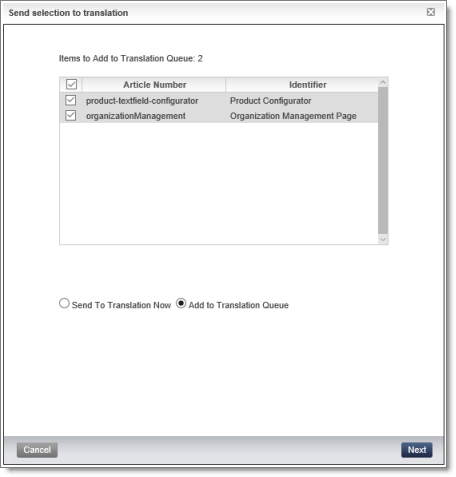
The following information is displayed about each page you selected previously:
- Name: The name of the page. This is displayed in the List view of the WCMS Cockpit.
- Identifier: The label of the page in the WCMS Cockpit. This is the same as the Label field displayed in a page’s editing view in the WCMS Cockpit.
Tip: You can clear the check box for any page you do not want to send out for translation.
- Select one of the following radio buttons:
- Add to Translation Queue (the default selection): The Connector sends the pagesto the Translation Queue, where a user must send them out for translation.
- Send to Translation Now: The Connector sends the pages to the Lionbridge Content API Platform, which sends them to the translation provider specified in the company’s routing rules. The Connector displays additional fields below, where you can specify additional information about this translation job.
Note: This setting determines which fields are displayed on the following page of the wizard.
- Click Next.
- One of the following happens.
- If you previously selected the Add to Translation Queue radio button, the second page of the wizard is displayed as follows:

- If you previously selected the Send to Translation Now radio button, the second page of the wizard is displayed as follows:

- Enter the following information about the content items to translate:
| Field | Description |
|---|---|
| Source Language | Required. Select the source language of the selected items to send for translation. Note: All selected items must have the same source language. |
| Target Language | Required. Select the check boxes of one or more target languages into which to translate the content. |
| LSP | Select the translation provider for this translation job from the list. Required and displayed only if you selected the Send to Translation Now radio button in the previous page of the wizard. |
| Job Name | Your name for this translation job. A translation job contains all the content items that the Connector sends out together for translation. Required and displayed only if you selected the Send to Translation Now radio button in the previous page of the wizard. |
| PO Reference | The purchase order reference number. Displayed only if you selected the Send to Translation Now radio button in the previous page of the wizard. |
| Notes to Translator | Any special instructions or requests. Displayed only if you selected the Send to Translation Now radio button in the previous page of the wizard and when any translation provider other than Lionbridge Freeway is selected in the LSP field, above. |
| Special Instructions | Any special instructions or requests. Displayed only when both: * Send to Translation is selected in the previous page of the wizard. * The Lionbridge Freeway translation provider is selected in **Choose LSP**, above. |
| Analysis Codes | You can specify the configured Lionbridge Freeway analysis codes for the translation job. Displayed only when both: * Send to Translation is selected in the previous page of the wizard. * The Lionbridge Freeway translation provider is selected in **Choose LSP**, above. |
- Click Next.
Note: The Next button is displayed only after you populate all required fields, which are marked with an asterisk (*).
Tip: If the last required field you populate is Job Name, click anywhere in the user interface to display the Next button.
-
If you selected the Send to Translation Now radio button in the previous page of the wizard, then the final page of the wizard states the number of items that were sent out to translation. Click Done to close the wizard.
-
If you selected the Add to Translation Queue radio button in the previous page of the wizard, then the final page of the wizard states the number of items that were sent to the queue. Click Done to close the wizard.
Important: You must open the Translation Queue to send out these items for translation. For detailed instructions, see Sending Items for Translation from the Translation Queue.
3.8 - Sending Items for Translation from the Translation Queue
The goal of the Translation Queue is to control translation costs and the translation process. This design assumes that the person with the authority to send content for translation from the Translation Queue manages the translation budget of the organization.
You can send out one, multiple, or all items from the Translation Queue at one time.
You originally submitted items to the Translation Queue by doing one of the following:
- in the Job Type page of the Send to translation wizard in the SAP Commerce Backoffice Product Cockpit, clicking the Add to Queue radio button. For details, see: Sending Products for Translation from SAP Commerce or SAP Commerce Cloud.
- in the Job Type page of the Send to translation wizard in the Hybris Backoffice Product Cockpit, clicking the Add to Queue radio button. For details, see: Sending Products for Translation from the Hybris Backoffice Product Cockpit (Hybris 6.4 and higher).
- in the Job Type page of the Send to translation wizard opened from the Hybris Backoffice Products Page, clicking the Add to Queue radio button. For details, see: Sending Products for Translation from the Hybris Backoffice Products Page.
- in the first page of the Send selection to translation wizard in the Hybris Product Cockpit, clicking the Add to Translation Queue radio button. For details, see: Sending Products for Translation from the Hybris Product Cockpit (Hybris 6.1 to 6.6).
- in the Job Type page of the Send to translation wizard opened from the Page page in SAP Commerce or SAP Commerce Cloud. clicking the Add to Queue radio button. For details, see: Sending Website Pages for Translation from SAP Commerce or SAP Commerce Cloud.
- in the Job Type page of the Send to translation wizard opened from the Page page in the Hybris Backoffice. clicking the Add to Queue radio button. For details, see: Sending Website Pages for Translation from the Hybris Backoffice.
- in the first page of the Send selection to translation wizard in the Hybris WCMS Cockpit, clicking the Add to Translation Queue radio button. For details, see: Sending Website Pages for Translation from the Hybris WCMS Cockpit (Hybris 6.1 to 6.6).
Submitting content to the Translation Queue before sending it out for translation has the following advantages:
- You may not want to send out the localized attributes in each business object individually as soon as you finish reviewing it. The Translation Queue facilitates your management of reviewed items, so that you do not forget about sending individual reviewed items for translation.
- Your translation provider may prefer receiving fewer but larger batches of items to translate, rather than items from individual business objects, as it facilitates project preparation, resource assignment, and content analysis.
- If you want to translate many items into multiple languages, but you want to translate into only one target language at a time, this is a good way to manage that process.
- The Translation Queue manager may want to route jobs to certain translation providers.
- The Translation Queue manager may want to add job-specific metadata, such as a purchase order number.
If you or your colleagues have sent items to the Translation Queue, you must access the Translation Queue to send out the items from there.
Note: If you do not send out items from the Translation Queue, the items remain in the queue, and the Connector does not send them out for translation.
To submit one or more items from the Translation Queue for translation:
- Do one of the following:
- In Hybris:
- In your Web browser, navigate to /backoffice/ on your Hybris instance.
- Log in to the Hybris Backoffice.
- In the Administration menu, select Translation Queue.
- In SAP Commerce or SAP Commerce Cloud:
- In your Web browser, navigate to /backoffice/ on your SAP Commerce instance or on SAP Commerce Cloud.
- Log in to SAP Commerce or SAP Commerce Cloud.
- In the Administration Cockpit menu, select Translation Queue.
The Translation Queue opens.

The following information is displayed about each item in the queue:
- Item Name: The name of the business object to send for translation. If the name is long, this wraps to the next row.
- Source Language: The name and language code of the source language of the business object to send for translation. This was specified when the business object was added to the queue.
- Target Language: The name and language code of the target language into which to translate the business object.
Note: If you specified translating a business object into multiple target languages, then each instance of a source language-target language pair is displayed in a separate row in the list, as a separate item. For example, if you want to translate a business object into five languages, then there are five rows in the list, one for each target language.
- Date Added: The date the business object was added to the queue, in the following format: MM/DD/YYYY.
The header and footer display information about how many items are in the queue, and how they are displayed. If there are more than 25 items in the queue, they are displayed in multiple sub-pages.
- The left sides of the header and footer display the total number of sub-pages in the queue. To navigate to a different sub-page, enter the sub-page number or click an arrow.
- The right sides of the header and footer display the total number of items displayed on the current sub-page of the queue and the total number of items in the queue.
-
Optional. Click a column heading to sort by a column or to reverse the sort order of a sorted column.
-
Optional. In the top of the queue, you can filter the displayed items in the queue. You can search by the following criteria:
- item name
- source language
- target language
Click Search.
Tip: To clear your search filters, click Clear Filter.
-
Optional. Click Refresh in the top-right corner of the list to update the items in the queue.
-
In the list, select the check boxes of the items that you want to send out for translation.
Tips: To select the check boxes of all items in the sub-page, select the check box in the column header. If all check boxes in the sub-page are selected, clear the check box in the column header.
Note: To remove items from the queue, select the corresponding check boxes and click Remove Select Item.
- Click Send to Translation.
The Send Items to Translation dialog box opens.
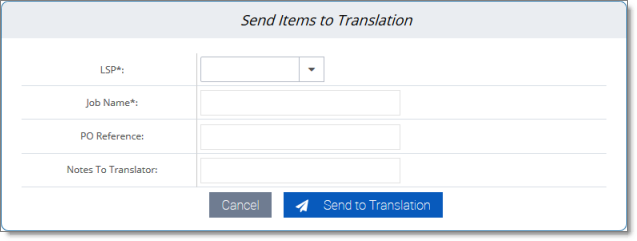
- Enter the following information about the items to translate:
| Field | Description |
|---|---|
| LSP | Select the translation provider for this translation job from the list. |
| Job Name | Your name for this translation job. |
| PO Reference | Optional. The purchase order reference number for this translation job. |
| Notes to Translator | Any special instructions or requests. Displayed only when any translation provider other than Lionbridge Freeway is selected in the LSP field, above. |
| Special Instructions | Any special instructions or requests. Displayed only when the Lionbridge Freeway translation provider is selected in the LSP field, above. |
| Analysis Codes | You can specify the configured Lionbridge Freeway analysis codes for the translation job. Displayed only when the Lionbridge Freeway translation provider is selected in Choose LSP, above. |
- Click Send to Translation.
A message box confirms that the Connector started processing the translation job with the selected items. Click OK to close the message box.
4 - Monitoring Translation Status
After you send out a job for translation, you can monitor its progress in the Translation Jobs page.
To monitor translation status:
- Do one of the following:
- In Hybris:
- In your Web browser, navigate to /backoffice/ on your Hybris instance.
- Log in to the Hybris Backoffice.
- In the Administration menu, select Translation Jobs.
- In SAP Commerce or SAP Commerce Cloud:
- In your Web browser, navigate to /backoffice/ on your SAP Commerce instance or on SAP Commerce Cloud.
- Log in to SAP Commerce or SAP Commerce Cloud.
- In the Administration Cockpit menu, select Translation Jobs.
The Translation Jobs page opens.

This page displays the following information about each translation job:
| Column | Description |
|---|---|
| Job Name | The name of this translation job. To view detailed information about the items in the job, click the link. If an error has occurred affecting the entire job, a red error icon is displayed in front of the job name. You can see the detailed error message by clicking on the icon. |
| Tracking ID | Tracking Id for the job, when you need to contact Lionbridge for support wrt to certain job, this tracking id will help Lionbridge quickly and accurately identify the job in question. |
| LSP | The translation provider to whom the Lionbridge Content API Platform sends the translation job. |
| Translation Status | The translation status of the job. For a list and description of translation statuses, see Translation Statuses. Note: If the Enable multiple deliveries setting is configured, then the Reviewing Translation status is displayed after translated content is received. If the translated content is not satisfactory, it can be re-delivered and re-imported into Hybris or SAP Commerce. You can click Approve to accept the translated content, which changes the job’s status to Completed and prevents any future re-deliveries. For more information about the Enable multiple deliveries setting, refer to the Lionbridge Connector for SAP Commerce Installation and Configuration Guide. 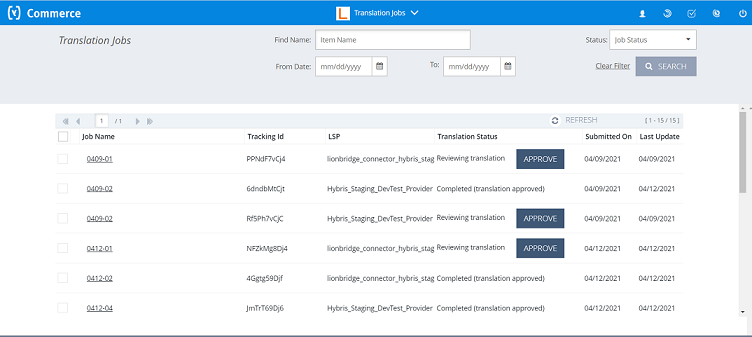 |
| Submitted On | The job submission date, in the following format: MM/DD/YYYY. |
| Last Update | The date the job was last updated, in the following format: MM/DD/YYYY. |
- Optional. Click a column heading to sort by a column or to reverse the sort order of a sorted column.
Tip: If you click the Translation Status column header to sort by this column, the jobs are sorted by percentage completed.
The list header and footer display the total number of items, and the total number of items displayed on this sub-page. If there are more than 25 items, they are displayed in multiple sub-pages.
- The left sides of the header and footer display the total number of sub-pages in the list. To navigate to a different sub-page, enter the sub-page number or click an arrow.
- The right sides of the header and footer display the total number of items displayed on the current sub-page of the list and the total number of items in the list.
-
Optional. Click Refresh in the top-right corner of the list to update the items in the list.
-
Optional. In the top-right corner of the page, search for the jobs whose translation status you want to view. You can search by any of the following criteria:
- Find Name: Enter the job name.
- Status: Select the translation status. For a list and description of translation statuses, see Translation Statuses.
- From Date and To: Specify the range of job-creation dates in the following format: MM/DD/YYYY, or click the calendar icon
 to select the dates.
to select the dates.
Click Search.
Tip: To clear your search filters, click **Clear Filteviewing_archived_jobsviewing_archived_jobs
- Optional. To view detailed information about the items in the job, click the link in the Job Name column.
For details, see Viewing Job Details.
Note: This action highlights this job and selects the corresponding check box.
- Optional. If this job has Reviewing translation status, you can click Approve to accept the translated content, which changes the job’s status to Completed and prevents any future re-deliveries.
- Optional. If this job has either Reviewing translation or Completed (nothing to translate) status, you can archive it by clicking the Archive this job link. You can view an archived job in the Archived Jobs page. For details, see Viewing Archived Jobs.
Warning: Archiving active jobs is not recommended. If you archive an active job, it will no longer be displayed on the Translation Jobs page. Archiving a job also archives the assets in that job: If you archive content while it is being translated, then the Connector will not return the completed translation to you.
- Optional. To view all archived jobs, click the Archived Jobs link at the bottom of the page. For details, see Viewing Archived Jobs.
4.1 - Translation Statuses
After you send out localized attributes of business objects for translation, they are referred to as content items. The Connector sends out one or more content items for translation as a single translation job. Both content items and translation jobs can have the following translation statuses:
| Translation Status | Description |
|---|---|
| Created | The Connector created the job for sending out the item to the translation provider. |
| Pending | The Connector is preparing to send out the item to the translation provider. |
| Sending | The Connector is sending out the item to the translation provider. |
| In translation | The translation provider has received the item for translation and has not yet returned the translated item. |
| Reviewing Translation | The Connector has received the translated item back from the translation provider and imported it into Hybris. Note: This is an intermediate state. If a job is stuck in this state, then an error may have occurred when the Connector imported the translation. |
| Completed | The Connector has returned the translated item to Hybris or Commerce Cloud. You view translated content items in the interfaces where those content items are displayed. For detailed instructions, see Viewing Translated Content. |
4.2 - Viewing Job Details
You view job details in the Job Details page. To open this page, in the Translation Jobs page, click the link in the Job Name column. For details, see Monitoring Translation Status

Note: You can also view the details of an archived job by clicking the link in the Job Name column in the Archived Jobs page. For details, see Viewing Archived Jobs.
The area at the top of the page displays the following read-only information about the job:
| Field | Description |
|---|---|
| Job ID | The Connector’s unique identifier for the job and tracking id of the job in bracket. |
| Job Name | Your name for this translation job. |
| Submitted On | The date, in MM/DD/YYYY format, when the job was submitted for translation. |
| Created By | The name of the user who submitted this job for translation. |
| Notes to Translator | Any special instructions or requests for the translation provider. |
| Special Instructions | Any special instructions or requests. Note: Displayed only when the Lionbridge Freeway translation provider is selected in the Translation provider field, below. |
| Last Update | The date, in MM/DD/YYYY format, when the job was last updated. |
| PO Number | The purchase order reference number for this translation job. |
| Job Status | The translation status. For a list and description of translation statuses, see Translation Statuses. |
| Translation provider | The translation provider for this job. |
The list header and footer display the total number of assets in the job, and the total number of assets displayed on this sub-page. If there are more than 8 assets, they are displayed in multiple sub-pages.
- The left sides of the header and footer display the total number of sub-pages in the list. To navigate to a different sub-page, enter the sub-page number or click an arrow.
- The right sides of the header and footer display the total number of assets displayed on the current sub-page of the list and the total number of items in the list.
This page displays the following information about each asset in the job:
| Column | Description |
|---|---|
| Asset ID | The Connector’s unique identifier for the item sent for translation, which includes information about the item, the target language, and the source language. If an error has occurred affecting the asset, a red error icon is displayed in front of the asset id. You can see the detailed error message by clicking on the icon. |
| Asset Name | * For a Product or a Product descendant type, this is: Product (article code)_name_PK #. * For a Category, this is: Category (article code) . * For a website page, this is the page name. |
| Source | The source language of the item. |
| Target | The target language of the item. |
| Status | The translation status. For a list and description of translation statuses, see Translation Statuses. |
| Last Update | The time and date when the status was last updated, in the following format: MM/DD/YYYY. |
| Asset Reference | The translation provider’s reference for the asset. |
- To return to the previous page, click the Return to list link or arrow at the top-left corner of the page.
- To archive this job, click the Archive this job link in the top-right corner of the page.
4.3 - Viewing Archived Jobs
You can view archived jobs in the Archived Jobs page.
To view archived jobs:
-
In the Translation Jobs page, click the Archived Jobs link at the bottom of the page. For instructions on opening that page, see Monitoring Translation Status.
-
The Archived Jobs page opens.
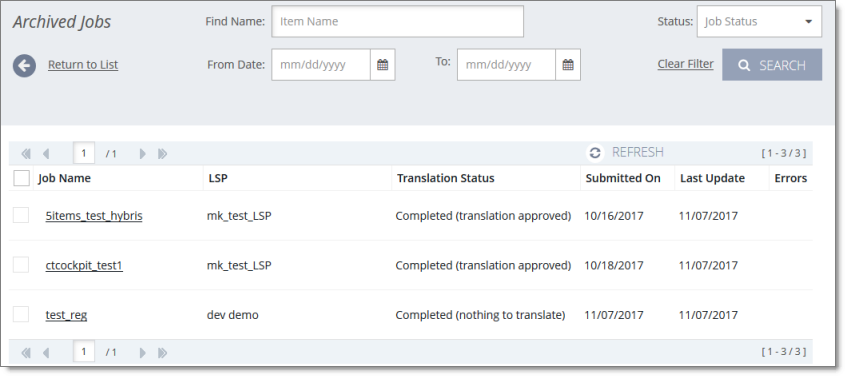
This page displays the following information about each archived translation job:
| Column | Description |
|---|---|
| Job Name | The name of this translation job. To view detailed information about the items in the job, click the link. |
| LSP | The translation provider to whom the Lionbridge Content API Platform sends the translation job. |
| Translation Status | The translation status of the job. For a list and description of translation statuses, see Translation Statuses. |
| Submitted On | The job submission date, in the following format: MM/DD/YYYY. |
| Last Update | The date the job was last updated, in the following format: MM/DD/YYYY. |
| Errors | If an error has occurred, it is displayed here. |
By default, the items are sorted chronologically by submission date.
The list header and footer display the total number of items, and the total number of items displayed on this sub-page. If there are more than 25 items, they are displayed in multiple sub-pages.
- The left sides of the header and footer display the total number of sub-pages in the list. To navigate to a different sub-page, enter the sub-page number or click an arrow.
- The right sides of the header and footer display the total number of items displayed on the current sub-page of the list and the total number of items in the list.
- Optional. In the top-right corner of the page, search for the jobs whose translation status you want to view. You can search by any of the following criteria:
- Find Name: Enter the job name.
- Status: Select the translation status. For a list and description of translation statuses, see Translation Statuses.
- From Date and To: Specify the range of job-creation dates in the following format: MM-DD-YYYY
Click Search.
Tip: To clear your search filters, click Clear Filter.
-
Optional. To view detailed information about the items in the job, click the link in the Job Name column. For details, see Viewing Job Details.
-
To return to the Translation Jobs page, click the Return to list link or arrow at the top-left corner of the page.
5 - Viewing Translated Content
When a job has Completed status, the items in that job have been translated and returned to Hybris. For a description of translation statuses, see Translation Statuses. You view translated content items in the interfaces where those content items are displayed:
- Viewing Translated Products in SAP Commerce or SAP Commerce Cloud
- Viewing Translated Products in the Hybris Backoffice Product Cockpit (Hybris 6.4 and higher)
- Viewing Translated Products in the Hybris Backoffice Products Page
- Viewing Translated Products in the Hybris Product Cockpit (Hybris 6.1 to 6.6)
- Viewing Translated Website Pages in in SAP Commerce or SAP Commerce Cloud
- Viewing Translated Website Pages in the Hybris Backoffice
- Viewing Translated Website Pages in the Hybris WCMS Cockpit (Hybris 6.1 to 6.6)
5.1 - Viewing Translated Products in SAP Commerce or SAP Commerce Cloud
When a job has Completed status, the products in that job have been translated and returned to SAP Commerce or SAP Commerce Cloud, where you can view them.
To view translated products in SAP Commerce or SAP Commerce Cloud:
- In your Web browser, navigate to /backoffice/ on your SAP Commerce instance or on SAP Commerce Cloud.
- Log in to SAP Commerce or SAP Commerce Cloud.
- In the Administration Cockpit menu, select Product Cockpit.
- In the bottom-right corner, click the arrow to display the left menu
 .
. - In the left menu, select Products.
The Products page opens.

-
Optional. In the Filter Tree in the left pane, you can select a specific catalog or classification, and price range and/or category to display only products that meet the filter criteria.
-
Locate the translated product. You can view the items in either the Grid view
 or the List view
or the List view  .
.
Tip: You can use the search and filter functionality at the top of the page to display only specific products .
-
Click the link in the product.
-
In the Properties tab, click the localization button
 to display a property in each of its languages. For example, if the description of the Plier Set (3 Pack) was translated from English into Japanese, the source (English) version is displayed as follows:
to display a property in each of its languages. For example, if the description of the Plier Set (3 Pack) was translated from English into Japanese, the source (English) version is displayed as follows:

While the target translation (Japanese) is displayed as follows:
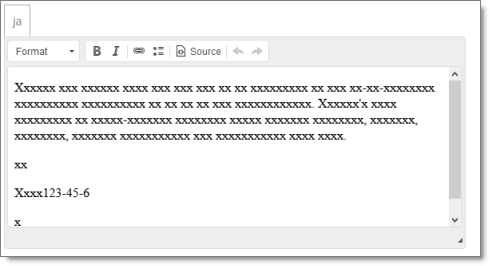
Note: Pseudo-translation is displayed instead of Japanese in the screen capture above.
5.2 - Viewing Translated Products in the Hybris Backoffice Product Cockpit
Note: This functionality is supported only for Hybris versions 6.4 and higher.
When a job has Completed status, the products in that job have been translated and returned to the Hybris Product Cockpit. You can view translated products in the Hybris Product Cockpit from the Hybris Backoffice.
To view translated products in the Hybris Backoffice Product Cockpit:
- In your Web browser, navigate to /backoffice/ on your Hybris instance.
- Log in to the Hybris Backoffice.
- In the Administration menu, select Product Cockpit.
The Products page opens.

- Optional. In the Filter Tree in the left pane, you can select a specific catalog or classification, and price range and/or category to display only products that meet the filter criteria.

- Locate the translated product. You can view the items in either the Grid view
 or the List view
or the List view  .
.
Tip: You can use the search and filter functionality at the top of the page to display only specific products .
-
Click the link in the product.
-
In the Properties tab, click the localization button
 to display a property in each of its languages. For example, if the description of the Plier Set (3 Pack) was translated from English into Japanese, the source (English) version is displayed as follows:
to display a property in each of its languages. For example, if the description of the Plier Set (3 Pack) was translated from English into Japanese, the source (English) version is displayed as follows:

While the target translation (Japanese) is displayed as follows:

Note: Pseudo-translation is displayed instead of Japanese in the screen capture above.
5.3 - Viewing Translated Products in the Hybris Backoffice Products Page
When a job has Completed status, the products in that job have been translated and returned to the Hybris Product Cockpit. You can view translated products in the Products page in the Hybris Backoffice.
To view translated products in the Hybris Backoffice Products page:
- In your Web browser, navigate to /backoffice/ on your Hybris instance.
- Log in to the Hybris Backoffice.
- Ensure that the Administration menu is selected.
- In the navigation tree on the left, navigate to Catalog > Products.
The Products page opens.

- Optional. In the Filter Tree in the left pane, you can select a specific catalog or classification, and price range and/or category to display only products that meet the filter criteria.

- Locate the translated product. You can view the items in either the Grid view
 or the List view
or the List view  .
.
Tip: You can use the search and filter functionality at the top of the page to display only the products to send out for translation.
-
Click the link in the product.
-
In the Properties tab, click the localization button
 to display a property in each of its languages. For example, if the Identifier field of the P.C. Service Kit was translated from English into Japanese, both language versions are displayed as follows:
to display a property in each of its languages. For example, if the Identifier field of the P.C. Service Kit was translated from English into Japanese, both language versions are displayed as follows:

5.4 - Viewing Translated Products in the Hybris Product Cockpit (Hybris 6.1 to 6.6)
Note: This functionality is supported only for Hybris versions 6.1 to 6.6.
When a job has Completed status, the products in that job have been translated and returned to the Hybris Product Cockpit. You can view translated products in the Hybris Product Cockpit.
To view a translated product:
-
In your Web browser, navigate to /ctcockpit/ on your Hybris instance.
-
Log in to the Hybris Product Cockpit.
-
In the All Products tab, in either the Grid view or the List view, click the translated product to select it.
-
In the toolbar, click the Open in Edit Area button
 .
. -
In the Edit area, locate an attribute with a Language button
 .
.

- Click the Language button
 beside the field.
beside the field.
The area expands to display all language versions of the attribute.
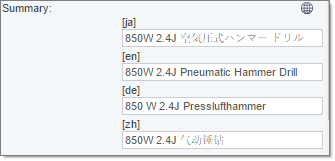
5.5 - Viewing Translated Website Pages in SAP Commerce or SAP Commerce Cloud
When a job has Completed status, the website pages in that job have been translated and returned to SAP Commerce or SAP Commerce Cloud, where you can view them.
To view a translated website page:
- In your Web browser, navigate to /backoffice/ on your SAP Commerce instance or on SAP Commerce Cloud.
- Log in to SAP Commerce or SAP Commerce Cloud.
- Ensure that the Administration Cockpit menu is selected. This is the default menu selection.
- In the navigation tree on the left, navigate to WCMS > Page.
The page that opens displays a list of website pages.

- Locate the translated website page. You can view the pages in the List View
 , Tree View
, Tree View  , or the Grid View
, or the Grid View  mode.
mode.
Tip: You can use the search and advanced search functionality to display only the website pages to send out for translation.
- Select the translated website page:
-
In the List view
 , click a checkmark
, click a checkmark  in the left column to select it and the corresponding page.
in the left column to select it and the corresponding page. -
In the Tree view
 , select a check box to select the corresponding page.
, select a check box to select the corresponding page. -
In the Grid view
 , select a a checkmark
, select a a checkmark  in the left column to select it and the corresponding page.
in the left column to select it and the corresponding page.
The bottom pane opens, displaying the page details. If necessary, click the expand icon ![]() to display more of the bottom pane.
to display more of the bottom pane.
- In the Properties tab, scroll down to an attribute with a localization button
 .
.
Click the localization button ![]() to display a property in each of its languages. For example, click the localization button for the Page title property of the Returns page.
to display a property in each of its languages. For example, click the localization button for the Page title property of the Returns page.
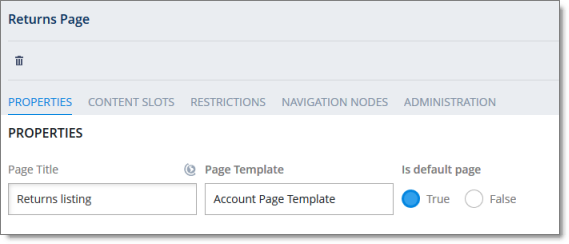
This section expands to display the translations of this property:
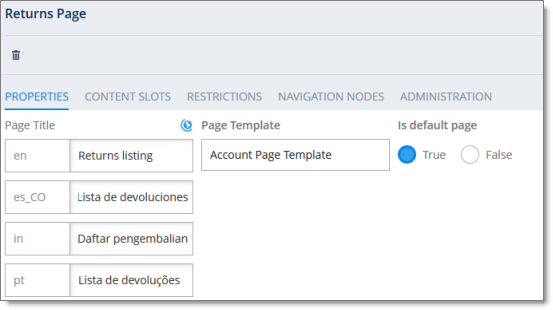
5.6 - Viewing Translated Website Pages in the Hybris Backoffice
When a job has Completed status, the website pages in that job have been translated and returned to the Hybris WCMS Cockpit. You can view the translated website pages in the Hybris Backoffice.
To view a translated website page:
- In your Web browser, navigate to /backoffice/ on your Hybris instance.
- Log in to the Hybris Backoffice.
- Ensure that the Administration menu is selected.
- In the navigation tree on the left, navigate to WCMS > Page.
The page that opens displays a list of website pages.

- Locate the translated website page. You can view the pages in the List View
 , Tree View
, Tree View  , or the Grid View
, or the Grid View  mode.
mode.
Tip: You can use the search and advanced search functionality to display only the website pages to send out for translation.
- Select the translated website page:
-
In the List view
 , click a checkmark
, click a checkmark  in the left column to select it and the corresponding page.
in the left column to select it and the corresponding page. -
In the Tree view
 , select a check box to select the corresponding page.
, select a check box to select the corresponding page. -
In the Grid view
 , select a a checkmark
, select a a checkmark  in the left column to select it and the corresponding page.
in the left column to select it and the corresponding page.
The bottom pane opens, displaying the page details. If necessary, click the expand icon ![]() to display more of the bottom pane.
to display more of the bottom pane.
- In the Properties tab, scroll down to an attribute with a localization button
 .
.
Click the localization button ![]() to display a property in each of its languages. For example, click the localization button for the Page title property of the Returns page.
to display a property in each of its languages. For example, click the localization button for the Page title property of the Returns page.

This section expands to display the translations of this property:

5.7 - Viewing Translated Website Pages in the Hybris WCMS Cockpit (Hybris 6.1 to 6.6)
Note: This functionality is supported only for Hybris versions 6.1 to 6.6.
When a job has Completed status, the website pages in that job have been translated and returned to the Hybris WCMS Cockpit. You can view the translated website pages in the Hybris WCMS Cockpit.
To view a translated website page:
- In your Web browser, navigate to /ctwcms/ on your Hybris instance.
- Log in to the Hybris WCMS Cockpit.
- In the navigation area, in the Websites box, click the catalog version of the website whose translated page you want to view.
- In the Filter tab, in either the Grid view or the List view, click the translated website page to select it.
- In the toolbar, click the Edit button
 .
. - In the Edit area, locate an attribute with a Language button
 .
.

- Click the Language button
 beside the field.
beside the field.
The area expands to display all language versions of the attribute.
